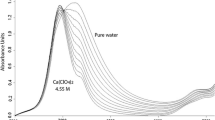Abstract
A new characterization procedure for aqueous solutions with unknown composition was proposed based on the binomial distribution of TOC (total organic carbon) fraction in terms of a characterizing variable, the Freundlich coefficient, k, so that the solution in question can be described by a finite number of pseudo.species identified with a certain k value. The validity and computational accuracy of this procedure has been demonstrated by characterizing three sets of experimental data chosen from different sources. Predictions based on this procedure yielded acceptable results that agreed closely with experimental data.
Similar content being viewed by others
Abbreviations
- A:
-
area uf the solution-solid interface, [m2]
- c:
-
concentration in solution, [ppm or mol/m1]
- c;r:
-
total adsorbale concentration in solutioi:. [ppni or mob’nr’]
- F:
-
object function or averaged error defined in Eq. (18)
- k:
-
Freundlich constant
- ks:
-
stale factor of k value
- m:
-
mass of adsorbent, (kg]
- M:
-
number of data
- n:
-
reciprocal of Freundlich exponent
- N:
-
number of pseudospecies
- q:
-
concentration in the adsorbed phase, [ppm or mob’kg]
- qT :
-
total adsorbate concentration in Ihe adsorbed phase, [ppm or niol/kg]
- R:
-
gas constant
- s:
-
skewness factor
- T:
-
temperature, [K]
- V:
-
volume of solution, [nr!]
- x:
-
TOC fraction in solution
- z:
-
TOC fraction in the adsorbed phase
- n :
-
spreading pressure
- II :
-
modified spreading pressure defined inVa (10)
- o:
-
single species state equilibrium
- i.j:
-
the i-th or j-lh species
- o:
-
initial value
- DAE:
-
differential adsorption equilibrium
- DOC:
-
dissolved organic carbon
- 1AE:
-
integral adsorption equilibrium
- TOC:
-
total organic carbon
References
Calligaris, M.B. and Tien, C.:Can. J. Chem. Eng.,60, 772(1982).
Dobbs, R.A. and Cohen, J.M.: “Carbon Adsorp- tion Isotherms for Toxic Organics”, EPA-60018- 80-02 (1980).
Kage, H.: Dr. Eng. Dissertation, Kyoto Univ., Kyto, Japan (1980).
Okazaki, M., Kage, H., Iijima, F. and Toei, R.:J. Chem. Eng. Japan,14, 26 (1981).
Jayaraj, K. and Tien, C:Ind. Eng. Chem. Process Design Development,24, 1230 (1985).
Crittenden, J.C., Luft, P. and Hand, D.W.:J. Wa- ter Research. 19, 1537(1985).
Hubele, C.: Dr.-Ing Dissertation, Karlsruhe Univ., Karlsruhe, Germany (1985).
Kage, H. and Tien, C.:Ind. Eng. Chem. Research,26, 284 (1987).
Radke, C.J. and Prausnitz, J.M.:AIChE J.,18, 761 (1972).
Moon, H. and Lee, W.K.:Chem. Eng. Sci.,41, 1995 (1986).
Moon, H. and Tien, C.:Ind. Eng. Chem. Re- search,26,2042(1987).
Moon, H. and Tien, C:AIChE Sym. Series 264,84, 23(1988).
Kreyszig, E.: “Advanced Engineering Mathematics”, 4th ed., John Wiley & Sons, New York, (1977).
Frick, F.B.: Dr.-lng Dissertation, Karlsruhe Univ., Karlsruhe, Germany (1980).
Author information
Authors and Affiliations
Rights and permissions
About this article
Cite this article
Moon, H., Kwoin, H.J. & Park, H.C. A new characterization procedure for aqufous solutions with unknown composition. Korean J. Chem. Eng. 7, 53–60 (1990). https://doi.org/10.1007/BF02697342
Received:
Accepted:
Issue Date:
DOI: https://doi.org/10.1007/BF02697342



